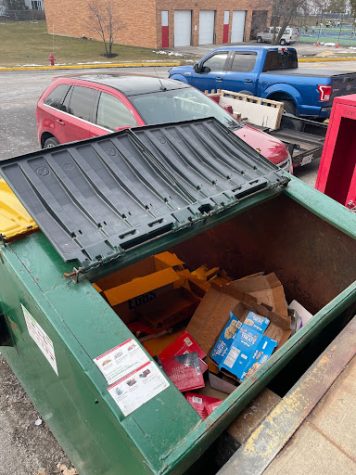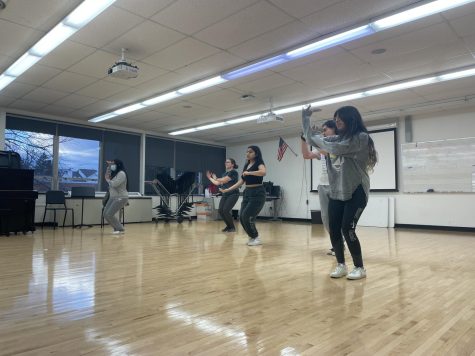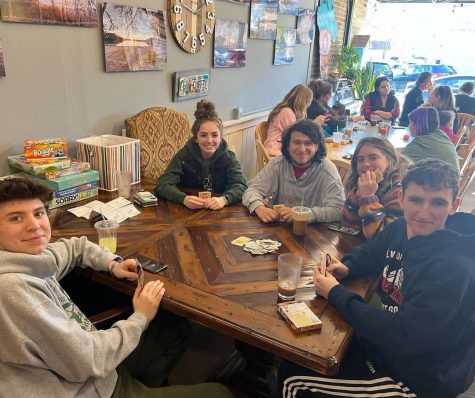Necessity breeds innovation: Staff reflects on effect of remote learning on teaching

Science Teacher Chris Michalides teaches his third period Honors Chemistry class, discussing how the metric system functions. He said he has looked forward to a return to in-person learning, to go back to the teaching style he had before remote learning. “I can monitor more students accurately and conveniently when in person,” he said. “Science is inherently hands-on for students and for me. Time to bring back the cool and dramatic demonstrations that make science interesting for many.”
September 20, 2021
The shift to remote learning at MHS starting in 2020 meant staff and students had to adapt in many ways, paving the path for increased incorporation of technology into school and fostering new perspectives on the role of education in the lives of students. As MHS returns to full in-person instruction, staff and students are able to see the potential lasting impact the pandemic has had on teaching and learning.
Reflecting on the past year, staff members said that remote learning has taught them more about how their students work and learn best as well as their varied needs.
“It wasn’t the greatest for learning for 95 percent of our students,” Brittany Bray, Spanish and French teacher, said, “But some students really appreciated not rushing around, not having the social pressures and stigmas of in-person learning. I think it’s important for us to find some times and some ways to gear our lessons to our introverts. So much of in-person learning is extrovert-oriented, and we need to give everyone time and space to process and work quietly from time to time. Also, we need to always make sure our classroom environment is a positive one, for everyone.”
The unique circumstances under which school had to be conducted led to a greater focus on the mental health of students– greater emphasis was placed on self-care and mental wellness, as the impact remote learning had on a large portion of students became clear.
“We had to overcome so many challenges and really rethink our jobs,” Bray said. “We had to plan how to teach the same skills in-person as online. Also, I think we came to value, more than ever, our connections with students and the importance of their well-being. I think we learned to be more attuned to their circumstances and mental health.”
Increased reliance on technology has opened new lines of communication between teachers and students, allowing students to speak up and ask for assistance when needed.
“I’m going to miss the ability to private message or sit in a breakout room with a small group or individual [on Zoom] because I feel like students got really great at communicating their needs, and I was better able to help them, so I’m looking for ways to bring those communication lines to in-person teaching as well,” Mary Plusinski, social studies teacher, said.
More subtle lines of communication, on the other hand, closed down during remote learning– impacting teachers’ abilities to gauge where students were having trouble or finding success.
“During full remote learning, it was unavoidable to teach at a slower pace,” Science Teacher Chris Michalides said. “I can’t eavesdrop on conversations to discover who is advancing and struggling. I can’t see who is watching YouTube on their phone or focused on their work. I can’t peek over someone’s shoulder and offer guidance if they unknowingly need it. I had to be very explicit and deliberate when visiting breakouts to have an idea of where they were at.”
Aside from the impact remote learning has had on communication and connections between teachers and students, MHS had to rely entirely on Chromebooks for the first time. Prior to the pandemic, many teachers used student Chromebooks as a supplement alongside traditional pencil-and-paper assignments.
Now that MHS has fully reopened, teachers can return to their previous teaching formats or choose to stay “paperless” and use online resources. In this aspect, staff are split– some look forward to casting aside the Chromebooks, and others want to implement them into their traditional curriculum more.
“I see benefits of going paperless in terms of conserving resources, costs and the convenience of not carting paper around,” Michalides said. “In light of these advantages, it’s still easier to use a pencil and paper to graphically demonstrate ideas, concepts, events and calculations. Yes, it can be done using Kami [an online annotation software] and other resources. Is it more convenient? You decide. And paper doesn’t need to be recharged.”
Social Studies Teacher Susan Theotokatos said she “pivoted halfway across the globe in terms of learning and rocking different platforms” and will most likely go “50-50” between online and paper work.
Special Education Teacher Valerie Riley said, “I’ll be mostly paperless because of passing germs, but also to save trees. I find that, for most students, Canvas helps keep things organized, so they can find what they’re looking for.”
Last year for remote learning, MHS introduced Canvas as its online learning management system for the entire school. It looks like Canvas is here to stay as each teacher is maintaining a Canvas course for each of the classes they teach.
Michalides described the benefits and drawbacks of the digital LMS, considering his experience with Canvas and his previous LMS of choice, Google Classroom.
“Remote teaching accelerated my acceptance of technology as a learning resource,” Michalides said. “I have relied on paper for most of my career until I discovered Google Classroom several years ago. That was a game-changer. Migrating assignments to digital forms is both [a] blessing and curse. Pros [include the following]: assignments are never “lost,” and returning assignments is more convenient. There is no sloppy handwriting to decipher. Students receiving test scores immediately is another plus. A negative is the complexity of Canvas. Creating assessments involves more steps compared to Google Classroom (my former LMS), and if technology doesn’t work, everyone suffers. I understand why some people like Canvas. I don’t have the same needs. Some of those benefits don’t carry over for me.”
Remote learning, then, potentially has had far-reaching impacts on the learning environment at MHS. To what extent these technological advancements will be welcomed into the in-person classroom may depend on the preferences of individual staff members, as some now feel more confident to take advantage of new possibilities of how to teach in a new age of education.

![MHS Alum Trey Baker hosting a MBK rising event on February ninth at the MHS annex. Said Baker, “I’m just really excited [and] super grateful for the community of Mundelein, for our educators, for our administration, at MHS who are really buying into this.”](https://mhsmustang.com/wp-content/uploads/2023/03/TreyBaker-350x475.jpg)

